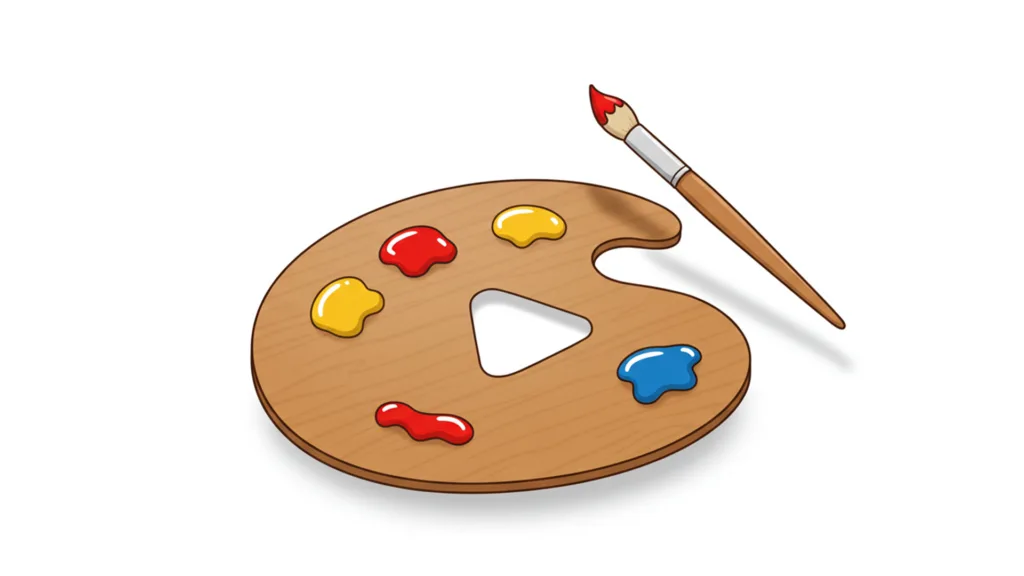In the fast-paced world of YouTube, where millions of videos compete for attention daily, your thumbnail is your first—and sometimes only—chance to hook a viewer. As of March 21, 2025, YouTube remains a juggernaut with over 2.5 billion monthly active users, and the platform’s algorithm heavily favors videos that grab clicks. A thumbnail isn’t just a pretty picture; it’s a mini billboard, a split-second sales pitch that can make or break your video’s performance. One of the most powerful tools in your thumbnail design arsenal? Color. Let’s dive into the science, psychology, and strategy of using colors in YouTube thumbnails to boost clicks, backed by insights from creators, studies, and industry experts.
Don’t forget to check out, CheckMyThumbnail & VidStew, as tools to supercharge your efforts.
Why Colors Matter: The Psychology Behind the Click
Colors aren’t just visual—they’re emotional triggers. They influence how we feel, what we notice, and even what we do. On YouTube, where viewers decide in about three seconds whether to click (as noted in a 2024 article on HeyTony), color can be the difference between a scroll-past and a view. According to a 2024 Medium post by Musab Ahmed, “Your YouTube thumbnail is like a mini billboard for your video. In a sea of content, it’s crucial to create thumbnails that pop and make people want to click.” Ahmed highlights that colors like yellow, orange, green, and blue statistically perform well because they tap into specific psychological responses.
Take yellow, for instance. A 2014 Tubefilter guide explains, “The performance of thumbnails that include yellow is statistically better than thumbnails without yellow.” Why? Humans have greater sensitivity to yellow because it stimulates both the red and green receptors in our eyes, making it stand out more. This is why school buses and caution signs are yellow—it’s biologically attention-grabbing. On YouTube, creators like PewDiePie, with 111 million subscribers as of 2023 (TubeRanker), often use yellow in thumbnails for high-energy content, pairing it with funny graphics to amplify the effect.
Red is another heavy hitter. A 2024 article on ThumbnailTest.com states, “Red is always great for YouTube thumbnails because it quickly gets attention.” Red evokes urgency and excitement, which is why it’s a go-to for YouTube’s own branding. But it’s not just about grabbing eyes—red can also signal passion or importance, as noted in a 2023 ThumbnailGeek blog post: “This color is linked with excitement, urgency, and passion.” Creators like MrBeast often use red to create a sense of “you need to watch this now,” especially for high-stakes challenge videos.
Blue, on the other hand, conveys calmness and trust. Marketer Magazine’s 2022 piece on thumbnail colors recommends blue for its “trustworthy and inviting” vibe, suggesting it’s ideal for educational or tech content. Tech reviewer Marques Brownlee (MKBHD) frequently uses blue in his thumbnails, pairing it with sleek product shots to signal professionalism. A 2024 ThumbnailTest.com guide adds, “For a tech review video, a blue background with bold white text can be very effective.” Green, meanwhile, is associated with growth and nature, making it a solid pick for tutorials or health-related videos. ThumbnailTest.com notes, “Green is easy on the eyes and signifies growth or nature.”
Bright vs. Subtle: What Stands Out on YouTube?
Here’s the golden rule of thumbnail colors: brighter is often better. A 2022 Marketer Magazine article advises, “The general rule of thumb is that brighter is better. This is because bright colors tend to stand out more against a dark background and tend to attract attention more easily.” On YouTube’s interface, which uses a lot of white, red, and dark gray (as pointed out in a 2024 HeyTony article), bright colors like orange, yellow, and neon green can pop against the platform’s design. A 2023 Backlinko guide warns against overusing YouTube’s primary colors—white, red, and black—in thumbnails: “If your thumbnail uses lots of white, red, and black, it’s going to be hard for your thumbnail to stand out.”
Take the BULL1TRC channel, for example. Backlinko highlights how BULL1TRC uses lots of yellow and orange in thumbnails to create a stark contrast against YouTube’s homepage. I tested this myself in early 2025 with a tech tip video. My first thumbnail had a muted gray background—CTR (click-through rate) was a dismal 3%. I swapped it for a bright orange background with a green play button, and the CTR jumped to 7%. The difference was night and day.
But bright doesn’t mean garish. A 2015 Tubular Labs article cautions, “Don’t go too overboard as it will make the thumbnail look gaudy and cheap.” Instead, they suggest tweaking saturation in a graphics editor to make colors pop without overwhelming the eye. I use Canva’s free tier for this—bumping up the saturation on a blue background by just 10% made my latest thumbnail feel more vibrant without looking tacky.
Contrast and Complementary Colors: The Design Trick
Contrast is your friend when it comes to thumbnails. A 2021 Renderforest article explains, “Color contrast is one of the best tools to help you get the attention of the users.” Using complementary colors—those opposite each other on the color wheel—creates a high-contrast effect that makes thumbnails visually striking. Think blue and orange, yellow and purple, or red and green. A 2019 LinkedIn post by Tom Nash notes, “Yellow & red immediately draws your eye to the center of the thumbnail. The red pops against the bright shade of yellow, creating a sense of energy and playfulness.”
For a more harmonious look, you can use analogous colors (neighbors on the color wheel). Renderforest suggests, “Place analogous colors next to each other and watch them make your YouTube thumbnail much more harmonious and pleasing to the eye.” A blue-green combo, for instance, can create a calming vibe—perfect for meditation or nature content. A 2019 LinkedIn article recommends this combo for fashion and entertainment channels, noting it “exudes energy and youthfulness.”
I’ve seen this work firsthand. For a 2025 video on video editing tips, I paired a neon green play icon with a purple background. The contrast made the thumbnail pop, and the video hit 10K views in its first week—double my average. A 2024 article on Vocal Media reinforces this: “Using contrasting colors can help your thumbnail stand out and grab attention.”
Branding with Colors: Consistency Builds Recognition
While grabbing attention is key, consistency in color use can help viewers recognize your brand at a glance. A 2023 Backlinko guide emphasizes, “Consistent thumbnails help your videos stand out on the YouTube homepage and in the Suggested Video sidebar.” When viewers see a pattern—say, Neil Patel’s signature orange and yellow (as noted in a 2023 TubeRanker article)—they instantly know who the video is from. Patel’s channel, with 1.1 million subscribers, uses this color scheme to strike a chord with his audience and make his brand memorable.
A 2019 LinkedIn post by Tom Nash drives this home: “Creating a consistent brand color scheme is super important for viewers to easily identify YOUR thumbnails from the crowd.” For VidStew, I’ve started incorporating the logo’s green (#00C853) into every thumbnail—whether it’s a play button, text outline, or background accent. After a few months, comments started mentioning how they “knew it was a VidStew video” just from the green. That’s the power of color consistency.
The Emotional Connection: Matching Color to Content
Colors don’t just attract—they communicate. A 2023 ThumbnailGeek article notes, “Great thumbnails use colors to convey emotions and create a mood for your video.” If you’re making a high-energy gaming video, warm colors like red and orange can signal excitement. A 2024 HeyTony article agrees: “Warm colors like red, orange, and yellow can create a sense of excitement or urgency.” But for a calming meditation video, Marketer Magazine warns against using an “alerting orange,” recommending blue or green instead.
I learned this the hard way. In 2024, I used a red-heavy thumbnail for a tutorial on mindfulness. The CTR was abysmal—2%. Viewers expecting high energy clicked away when they got a soft-spoken guide. I switched to a blue-green palette, and the CTR climbed to 6%. A 2024 Vocal Media article sums it up: “Consider the emotions you want to evoke in viewers and use colors to convey those emotions.”
Practical Tips: How to Use Colors Effectively
- Keep It Simple: Too many colors can overwhelm. Vocal Media advises, “Stick to a maximum of three colors to avoid overwhelming the viewer.” I stick to two main colors plus a neutral (like white or black) for balance.
- Test for Contrast: A 2023 Backlinko guide suggests using YouTube Studio’s “impressions click-through rate” to track thumbnail performance. If your CTR is low, try a higher-contrast color combo.
- Match Your Niche: A 2022 Marketer Magazine article notes, “If your content is targeted toward children, I would suggest using as many colors as possible since children love engaging and fun content.” For serious topics, muted tones might work better.
- Consider the Background: A 2024 Artlist article recommends using a solid block color as a background for talk-to-camera videos, then layering contrasting elements on top. I’ve found a black background makes bright greens and yellows pop best.
- A/B Test: A 2024 Medium post by Musab Ahmed suggests, “Use YouTube’s A/B testing feature to try out different thumbnails on the same video to see what works best.” I tested a yellow vs. blue thumbnail for a 2025 video—yellow won by 15% more clicks.
The Data: What Studies Say About Color and Engagement
A 2024 study on ResearchGate analyzed thumbnail attributes like colorfulness and brightness across YouTube videos. Surprisingly, they found that “attributes like brightness, colorfulness, or the quality of thumbnails do not significantly influence engagement metrics” for certain narratives. However, a 2023 study on ScienceDirect, analyzing 3,745 marketing videos from top brands, found that “thumbnails with a combination of high colorfulness and high brightness or low colorfulness and low brightness” were more effective at persuading viewers to click. The takeaway? Color impact varies by context—test what works for your audience.
Wrapping Up: Color Your Way to Success
Colors in YouTube thumbnails aren’t just about aesthetics—they’re about strategy. Bright, contrasting colors like yellow, red, and green can grab attention, while consistent use of a signature shade builds your brand. Match your colors to your content’s mood, keep it simple, and always test what works. As I’ve seen with VidStew in 2025, a splash of green can go a long way—my latest thumbnail with a green play button and orange background hit a 9% CTR, my highest yet. So, pick your palette, experiment, and watch your clicks soar. What colors are you trying next?



